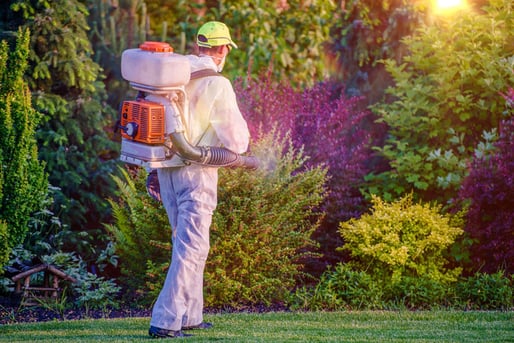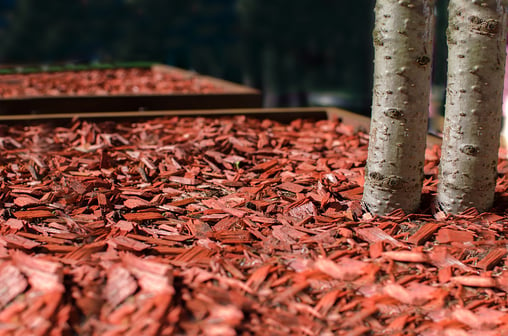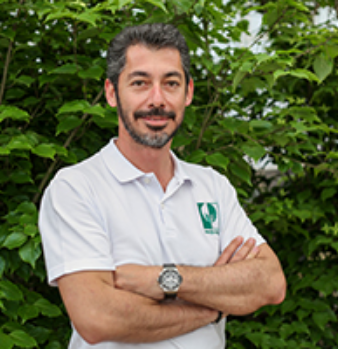Sustainable Landscape Maintenance can be scary, but it is possible. Here are our tips on how to protect your plants and the environment as a whole.Maybe you’ve read our blog on designing a sustainable landscape, or maybe you’re just looking for ways of maintaining your existing landscape in a sustainable way. Either way, you’ve come to the right place.
You might be wondering if it’s possible to build a completely self-sustaining landscape, and, well, quite frankly, so are we. Terrariums are a great example of a completely self-sustaining ecosystem and, while they look incredible indoors and are great fun to build, they can’t really be translated well outdoors or on a bigger scale.
So, what’s the answer?
Below, we’ll give you some tricks for maintaining your landscape in a sustainable way.
Pest Control
When we talk about pest control it’s easy to think of the small, annoying mites like blackfly, but it’s a broad term that covers everything from insects to rodents and plant diseases. Basically any organism that can be destructive to crops.
 Companion plants, such as basil, rosemary and lavender are the first thing to consider, and possibly the most natural way of preventing pests from taking over your landscape. They attract helpful insects such as bees but deter most unwanted pests, as well as having the additional benefit of providing a beautiful scent. Also, choosing native plants for your landscape will reduce pests due to the natural defenses the plants have evolved against the specific pests in that particular area.
Companion plants, such as basil, rosemary and lavender are the first thing to consider, and possibly the most natural way of preventing pests from taking over your landscape. They attract helpful insects such as bees but deter most unwanted pests, as well as having the additional benefit of providing a beautiful scent. Also, choosing native plants for your landscape will reduce pests due to the natural defenses the plants have evolved against the specific pests in that particular area.
If these techniques are insufficient, however, there are non-chemical ways of intervening, of which multiple should be employed at once.
Natural predators such as ladybirds and spiders can be encouraged in certain areas as they eat a large number of plant-disturbing pests, including those that carry diseases. They can be encouraged through plant diversity as well as “beetle banks”, which can be achieved through hydroseeding, and planting hedges.
Bio-fumigation is another technique that involves burying decomposing plant materials under the soil to produce a gas which will kill the pests. This does not harm the plants or have an impact on human health as only organic products are used, whereas chemical pesticides and herbicides often pollute local water sources after irrigation or heavy rainfall.
Erosion Control
 Soil erosion is a big problem causing no end of environmental damage and additional costs to business owners and governments alike, as sediment fills rivers, causing floods, harming aquatic life and increases the costs of water treatment. Compost-based erosion control works well by bonding with the soil to prevent disruption from heavy rainfall, increasing the volume of water able to be held by the soil, reducing weeds and insulating roots. An additional benefit of compost and mulch application is enhancing soil with organic nutrients, as the nutrients will fertilize the plant life and, if locally sourced, also reduces transportation needs.
Soil erosion is a big problem causing no end of environmental damage and additional costs to business owners and governments alike, as sediment fills rivers, causing floods, harming aquatic life and increases the costs of water treatment. Compost-based erosion control works well by bonding with the soil to prevent disruption from heavy rainfall, increasing the volume of water able to be held by the soil, reducing weeds and insulating roots. An additional benefit of compost and mulch application is enhancing soil with organic nutrients, as the nutrients will fertilize the plant life and, if locally sourced, also reduces transportation needs.
Plant Selection
Plant diversity is crucial to a sustainable landscape. Not only does a variety of plants contribute to pest control but choosing drought-resistant plants will inevitably help with water conservation. What’s more, choosing ground-cover plants will prevent weed growth, which will in turn prevent the release of CO2 into the atmosphere by minimizing the disruption of the soil.

Perennials are the best choice over annuals for this reason too. Whilst saving yourself time and effort replacing dying plants each year, or even each season, planting perennials will help reduce plant waste and near-constant soil disruption.
Living Green Walls can also benefit from planting perennials instead of annuals, as well as automatic irrigation systems, saving you money and water while maintaining stunning visuals. Sheet media as the base for your plants, is also preferred over loose media as it lasts up to 20 years rather than having to be replaced every two years due to the soil being blasted away by wind and rain.
Organic options instead of chemical products in plant nutrition and fertilization regulates the pH balance of the soil, increases the micro-organisms within and the nutritional value of the soil, and accelerates plant growth. At the same time, it increases the water retention of the soil and reduces the need for irrigation.
Lawn Care
The most important thing to say about lawns is that they are not the most environmentally friendly ground cover option. However, since they can look so stunning when well kept, we can advise you to keep your lawn area to a minimum and simply maintain them in a sustainable way. That means using an automated sprinkler system. Why is that? Automated irrigation systems monitor rainfall and work accordingly so that no water or energy is wasted during the watering process. Some can even use the excess rainwater that has been harvested by water butts or other collection systems, utilizing this water to save even more energy.
By choosing electrical alternatives for the equipment you use in your maintenance activities, you can both reduce the amount of emissions you release into the atmosphere and reduce noise.
Need Help?
Sustainable landscape maintenance is of course much easier if you have an appropriately and effectively designed landscape in the first place. Karaoglu Landscaping has a great deal of experience in design, developing and maintaining landscapes of all shapes and sizes. So, if you’re looking for ideas on how to refurbish or redesign your landscape, take a look at our blog on sustainable landscaping design here or why not look at our page on Living Green Walls here.
![karaoglu-web-footer[7].webp](https://blog.karaoglu.com.tr/hubfs/karaoglu-web-footer%5B7%5D.webp.png)
